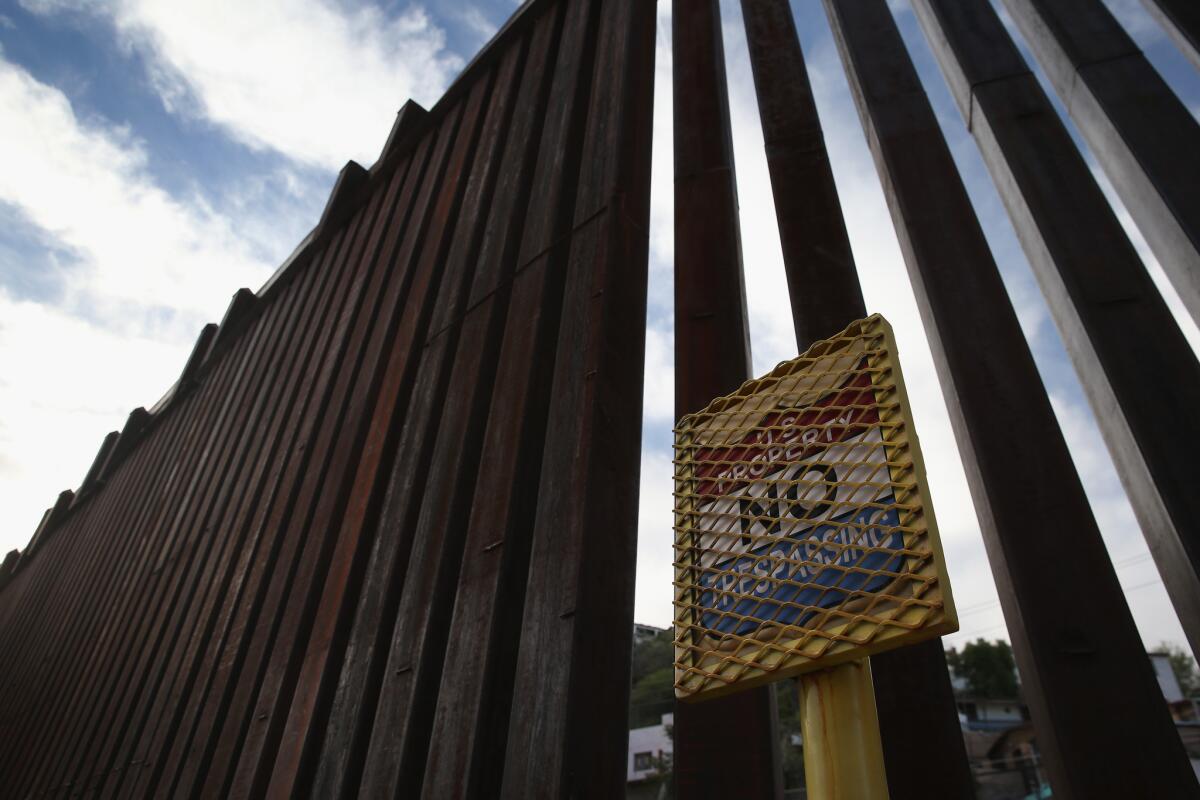Op-Ed: Border fences are succeeding -- in keeping migrants in U.S.

The U.S.-Mexico border fence in Nogales, Ariz.
In the first Republican presidential debate, Donald Trump swore he’d build a wall to keep out Mexican migrants and his GOP rivals lined up to assure voters that they would “secure the border.” What these aspiring candidates neglected to mention is that the United States has already shoveled tens of billions of dollars into border security, to no avail. Billions more won’t magically turn a failed strategy, fraught with unintended consequences, into a successful one.
The United States is now 22 years into an unprecedented buildup of border enforcement resources: 21,000 Border Patrol agents, nearly 700 miles of various kinds of physical fences, a fleet of drones, high-tech electronic surveillance systems covering all major cities along the border, a gulag of immigration prisons to incarcerate apprehended migrants, and more.
This massive effort, begun under President Clinton, has been sustained and expanded by all subsequent presidents. Congress after Congress, whether controlled by Democrats or Republicans, has generously bankrolled the project. To what end?
Measured by Border Patrol apprehensions, illegal entries from Mexico have declined to early 1970s levels. The micro-level evidence mirrors this trend. In one of the Mexican towns studied by my research team, the proportion of residents who were planning to go north fell to 2.5% in January 2015 from 17% in 2006.
But tougher border enforcement has little or nothing to do with this decline. It is largely a residue of the Great Recession, which dried up job opportunities for would-be migrants and created a perception that finding employment in the United States is now quite hard. A 2011 study by the National Research Council concluded: “Rising [border] enforcement does not seem to have played a significant role in lowering the likelihood of undocumented migration.”
Interviews with many thousands of actual migrants have revealed that the obstacle course on the border doesn’t keep people out. More than 9 out of 10 who come to the border succeed eventually in gaining entry, if not on the first try then the second or third. Fences can always be climbed over, dug under, or gone around.
Today’s prospective migrants are far more concerned about exposing themselves to violence in Mexico’s borderlands than about border fences. In our 2015 survey of potential migrants, only 7.6% cited “El muro,” the common term for today’s border wall, as their top concern, compared with 48% who feared being kidnapped by organized criminal gangs or assaulted by border bandits while making their way to the United States.
If the border buildup has benefited anyone, it’s professional people-smugglers, who are now hired by the vast majority of would-be Mexican migrants. The $3,000 to $6,000 fees that such “coyotes” can charge have risen by a factor of five or six, reflecting increased demand for their services.
So border security hasn’t kept migrants out — but it has kept them in. Indeed, the single most important outcome of our border buildup has been to end circular migration, in which migrants came to the U.S. for relatively short periods of employment and then returned to their home communities.
By making the southwestern border more costly and dangerous to cross, we have created powerful incentives for those who make it into the United States to remain here. The rise in smugglers’ fees, for instance, encourages undocumented migrants to extend their stay to amortize that expense over a longer period. If they go home, even for a short visit, they have to pay heavily to be smuggled back in.
Return migration to Mexico has dwindled to a trickle. In the 1960s, roughly 60% went back home within a year; today, fewer than 10% do. The result is a much larger population of permanently settled undocumented immigrants, with a much higher proportion of whole families with U.S.-born children. The long-term fiscal impact of this explosion of permanent settlers — larger outlays for education, healthcare, and other services — is conveniently overlooked by politicians who clamor for tighter security.
If politicians truly believe that further militarization of the border is cost-effective, where is the supporting evidence? Where is the proof that spending more on physical fencing — taller, stronger, longer — will do any good?
Absent such evidence, framing the 2016 presidential debate over immigration policy as a matter of who will do the most to “secure the border” is a cynical exercise in peddling a failed remedy while ignoring its significant unintended consequences.
Rather than double down on fence building, we should declare victory at the border and get on with the serious work of immigration reform. That includes ensuring that future flows of migrants will be predominantly legal and creating a meaningful path to legalization for millions of undocumented immigrants who are already here — and highly unlikely to go home.
Wayne A. Cornelius is director of the Mexican Migration Field Research and Training Program at UC San Diego. He has conducted field research on Mexican migration to the United States for more than four decades.
Follow the Opinion section on Twitter @latimesopinion and Facebook
More to Read
A cure for the common opinion
Get thought-provoking perspectives with our weekly newsletter.
You may occasionally receive promotional content from the Los Angeles Times.










